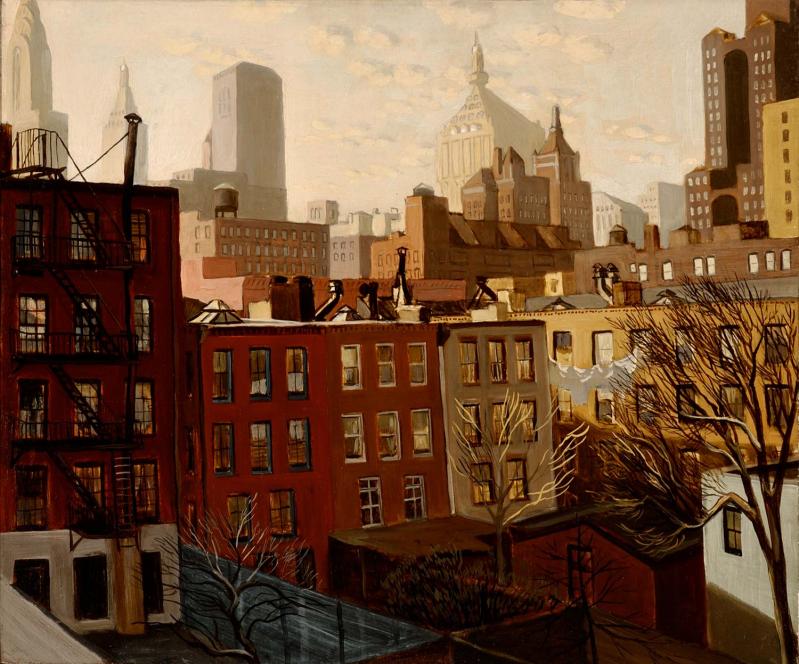While no one doubts that a significant bequest by a prominent artist is the dream of any museum, the responsibilities sometimes overtax the resources available. Without a dedicated space to house them, the works can languish in storage or flourish on walls far from their home as loans to other institutions.
The Whitney Museum of American Art's Edward Hopper collection is one example. The museum dutifully comes up with themed solo presentations to keep the works' context fresh and the art on the walls every several years or so, while it also includes some of the most famous works in generalized permanent collection installations. But many are the museum visitors from out of town who look forward to seeing a Hopper collection, when only a handful of paintings are on view.
The Parrish Art Museum has a similar happy conundrum with its Fairfield Porter collection. The artist's widow, Anne Porter, left the museum a sizable inventory of works, more than 240 (in comparison, the Whitney has more than 3,000 Hoppers). Porter, not as famous as Hopper, still has his fans. And he was a great and acknowledged influence on some of the following generation of artists, who adopted his naturalism as it applied to abstraction and vice versa.
The museum, which undertook a major building project in Water Mill more than a decade ago to help keep more of its permanent collection on view at all times, typically has a handful of Porters on the walls, either grouped together or thematically matched with other artists. Every so often, it too has a more significant showing with a theme. This time, the museum is stepping away from his portraits, the views inside and outside his house on South Main Street in Southampton, where he lived for decades, and the landscapes from Great Spruce Head Island in Maine, where he had another house, to focus on his cityscapes.
"Across the Avenues: Fairfield Porter in New York," beginning Sunday and up through June 16, will have 26 paintings and prints that the artist executed from the 1940s to the 1970s.
He treated New York much as he treated his neighborhood in Southampton, capturing its essence. But in contrast with the quiet repose of the village, the city scenes are energetic and animated. Cars and buildings, streetlights and traffic lights, and even the subway are represented here with views from building windows above the activity and on the street in the midst of it.
From this sampling, Porter appears to have been fascinated with the more human scale of brownstone residences contrasted with the outsized and even gigantic skyscrapers in the background, or with smokestacks and other signs of industry. Unlike his very focused Southampton views, his city subjects come from different streets, avenues, and neighborhoods, evidence of a kinetic fascination with the urban environment.
There are similarities with Hopper in these works, and it's probably not an accident that this show follows the Whitney's excellent "Edward Hopper's New York," which was mounted late in 2022 and stayed on view through early last year. A kind of economy in Porter's depictions of streets and buildings, particularly from the 1940s, doesn't seem too far off from the early abstraction of Stuart Davis either.
One head-scratcher on the checklist is the work titled "Turn," which could have been painted from Washington Heights, but seems to jibe more with the Palisades on the New Jersey side of the bridge in the background. A group of buildings with peaked roofs is in the right foreground, yet they don't feel very urban in nature.
According to the museum, Porter first came to New York during college and then moved to Manhattan in 1928, leaving for Europe during 1931. He returned in 1932 and married Anne Channing, staying until 1936 in two different apartments in Greenwich Village. Although the Parrish said he consistently painted street scenes during this period, none of these are on view. The show picks up from when he returned to the city in 1943 and stayed until the move to Southampton in 1949.
The majority of the works in the show come from this period. It then jumps to the 1960s and a kind of "Mad Men" aesthetic. The paintings and lithographs from the '60s feel nonspecific and looser, even while seeming edgier than the earlier works. Two views of Sixth Avenue from 1970s lithos are bathed in a pink smog. A slightly later version of Broadway has a similar rosy and gray palette.
Then, three other late paintings slide into abstraction. The depiction of that city light, particularly in the gloaming, was the point of the exercise, what he called portraits of Manhattan streets. Around the same time, he told a New York Times arts writer that the city's light was "far more beautiful than Paris or Rome."
Still, as the museum notes, Porter never wavered in his dedication to realism, while the art world around him vaporized it. But he also attracted many to his way of seeing, even when the important formalist critics of the day rejected his relevance.
His widow's gift was a generous and enduring one that allows us to see the influence of the immediate landscape on the artist as well as compare it to others he chose as subjects. His story is an important part of the art history of the East End, even when he was painting elsewhere.




